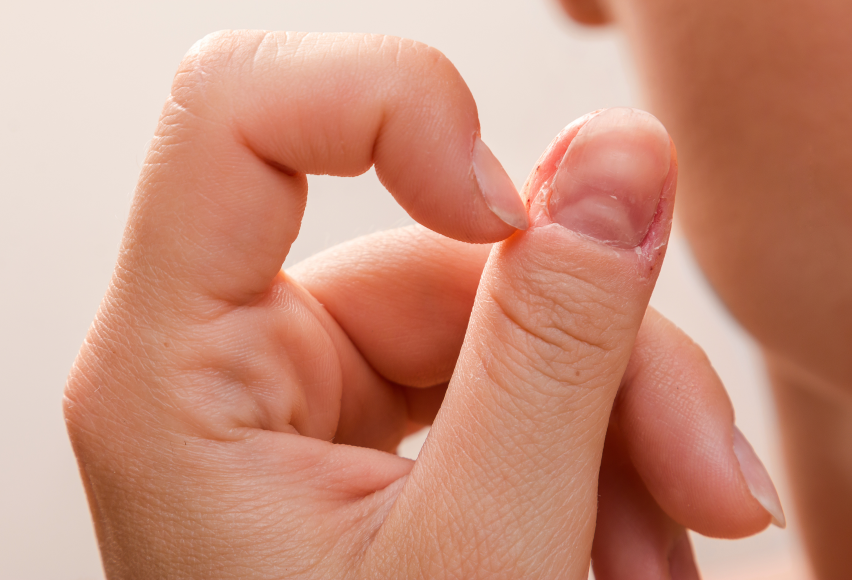
Online test
Find out the severity of your symptoms with this free online test
When you think of Obsessive-Compulsive Disorder (OCD), you might picture someone who washes their hands a lot or lines up their pencils just right. But OCD can be much more than that. And what about skin picking, also known as excoriation disorder? Is it just a bad habit, or something deeper? According to the DSM-5 (the big book doctors use to diagnose mental health stuff), both OCD and skin picking are part of a group called “Obsessive-Compulsive and Related Disorders” (American Psychiatric Association, 2013). But while they have some things in common, they’re also pretty different.
In this article, we’ll break down how OCD and skin picking are alike, how they’re different, and how they can affect each other. We’ll also talk about what causes them, how to deal with them, and what treatments work best.
What Is OCD?
Obsessive-Compulsive Disorder is a mental health condition where someone has obsessions (thoughts that won’t go away) and compulsions (behaviors they feel they have to do). These obsessions can be about anything—from fear of germs to worrying they’ll hurt someone even if they never would. The compulsions are the actions they take to try to stop the anxiety those thoughts cause. For example, someone might check the stove over and over to make sure it’s off.
According to the DSM-5, OCD symptoms must take up at least an hour a day and cause problems in daily life (American Psychiatric Association, 2013). It’s not just about being a “neat freak”—it’s something that really impacts how a person functions.
What Is Skin Picking Disorder?
Skin picking disorder, or excoriation disorder, is when a person picks at their skin so much that it causes damage. This isn’t the same as the occasional pimple-popping. People with this disorder might pick at scabs, acne, or even healthy skin, and they feel like they can’t stop—even when they want to. The DSM-5 includes this under the same group as OCD (OCRD), because it includes repetitive behaviors and is driven by urges that are hard to resist (American Psychiatric Association, 2013).
How Are OCD and Skin Picking Alike?
There are actually a few key similarities between the two. First off, both OCD and skin picking involve repetitive behaviors. People with OCD do things like wash their hands, check locks, or count things over and over. People with skin picking disorder might spend hours picking at their skin, sometimes without even noticing they’re doing it.
Both disorders can also cause a lot of stress and shame. People with OCD might feel embarrassed about their rituals, and those who pick their skin often hide their hands, arms, or faces to avoid judgment (Grant et al., 2012). Also, both disorders often start in the teen years and can last for many years if untreated.
Another big similarity? Both OCD and skin picking can be triggered by anxiety or stress. When someone with OCD has an intrusive thought, they engage in a compulsive action or behavior to feel better. With skin picking, the act of picking might temporarily relieve stress or give a sense of control (Farhat et al., 2023).
How Are They Different?
Even though they look alike in some ways, OCD and skin picking are actually quite different when you dig deeper. One big difference is the why behind the behavior.
With OCD, the compulsive behavior is usually caused by an intrusive, anxiety provoking thought. For example, someone might have an unwanted thought that if they don’t wash their hands a certain number of times, they or someone they love will get sick. It’s not logical, but it feels very real to them.
On the other hand, skin picking isn’t always linked to a thought or fear. A skin picking episode starts with an urge - the compelling need to pick. This can feel like a tickling on your skin or an inner tension. The urge can be caused by many things. Sometimes it’s a thought, stress, or a negative emotion. Other times it’s an imperfection in the skin or boredom. At some point it can turn into a habit triggered by actions such as driving your car, getting home after a long day or sitting in front of the TV. In many cases, the picking happens without much thought —kind of like biting your nails, but more extreme (Grant et al., 2012).
Also, people with OCD usually know that their thoughts and behaviors don’t make sense. This is called having "insight." But people with skin picking disorder might not always realize how bad their behavior is until they see the damage it’s causing.
Can OCD Cause Skin Picking?
Yes, in some cases, OCD and skin picking can happen together. In fact, research shows that about 15% to 28% of people with skin picking disorder also meet the criteria for OCD (Lochner et al., 2012). Sometimes the picking is actually a compulsion—a person might have obsessive thoughts about their skin being “contaminated” or “wrong” and pick at it to feel better.
But even when it’s not a full-on OCD compulsion, having OCD can make skin picking worse. People with high anxiety levels are more likely to develop repetitive behaviors to cope, and OCD can feed into that cycle. For example, someone might feel like they have to remove a blemish because it feels “just not right,” which can lead to constant picking.
Why Do These Disorders Happen?
Nobody knows exactly what causes OCD or skin-picking disorder, but it’s probably a mix of things. Genetics seem to play a role—if someone in your family has OCD or a related disorder, your chances are higher too (Mattheisen, 2021). Brain chemistry is another factor. People with OCD and skin picking often have differences in how their brains handle things like serotonin, a chemical that helps control mood.
Stress, trauma, and even certain personality traits (like being a perfectionist or anxious) can also increase the chances of developing these disorders. And once the behaviors start, they can become a habit that’s hard to break.
Coping Strategies and Therapies That Can Help
If you’re dealing with OCD or skin picking, there are ways to get help—and it usually starts with awareness. One of the most powerful tools for both OCD and skin picking is simply noticing your patterns. Journaling when and where the behavior happens can help you figure out what triggers it, like stress, boredom, or anxiety. You might start to see, “Oh, I tend to pick more at night,” or “I wash my hands way more when I’m anxious.” Being open about what you're going through instead of hiding it can also take away some of the shame, which can actually reduce the behavior. And mindfulness—just slowing down and tuning into how your body feels—can help you pause before acting on an urge.
For OCD, the most effective therapy is something called Exposure and Response Prevention (ERP). Sounds intense, but here’s what it really means: you slowly face the things that trigger your OCD (the “exposure”) without doing the usual compulsive behavior to make the anxiety go away (that’s the “response prevention” part). For example, if someone has contamination fears, they might practice touching a “dirty” doorknob without immediately washing their hands. Over time, this helps retrain the brain to realize those fears don’t need a ritual to go away. It can feel tough at first, but with a therapist’s help, it really works.
Skin picking responds really well to Habit Reversal Training (HRT). This approach helps people notice the urge to pick and swap it out with something else—like squeezing a stress ball, playing with a fidget toy, or even doodling. HRT also includes finding ways to block the behavior, like wearing gloves or covering mirrors if those are triggers. Some people keep band-aids on spots they usually pick to make it harder to start. Just like with OCD, therapy can be combined with medication like SSRIs if the symptoms are really getting in the way of daily life
Final Thoughts
OCD and skin picking may look similar on the surface, but they have different roots and show up in unique ways. Still, they share enough traits that they’re grouped together in the DSM-5, and they often appear side by side. Knowing how they work, how they affect each other, and how to handle them is a big step toward getting better.
- If you think you might be living with OCD or excoriation (skin picking) disorder, please consider taking a step toward help today. Learn more about effective treatments and support at StopOCD.com and SkinPick.com—these are trusted resources offering guidance, expert referrals, and tools to help you start your journey toward relief.
Don’t wait—there’s help out there, and recovery is possible.
References
- American Psychiatric Association. (2013). Diagnostic and statistical manual of mental disorders (5th ed.). https://doi.org/10.1176/appi.books.9780890425596
- Tolin, D. F. (Ed.). (2023). The Oxford handbook of obsessive-compulsive and related disorders (2nd ed.). Oxford University Press. https://doi.org/10.1093/oxfordhb/9780190068752.001.0001
- Grant, J. E., Odlaug, B. L., Chamberlain, S. R., Keuthen, N. J., Lochner, C., & Stein, D. J. (2012). Skin Picking Disorder. American Journal of Psychiatry, 169(11), 1143–1149. https://doi.org/10.1176/appi.ajp.2012.12040508
- Lochner, C., Roos, A., Stein, D. J. (2012). Excoriation (skin-picking) disorder: A systematic review of treatment options. Neuropsychiatric Disease and Treatment, 8, 23–31.https://pubmed.ncbi.nlm.nih.gov/28761349/
- Farhat, L. C., Reid, M., Bloch, M. H., & Olfson, E. (2023). Prevalence and gender distribution of excoriation (skin-picking) disorder: A systematic review and meta-analysis. Journal of Psychiatric Research, 161, 412–418.https://pmc.ncbi.nlm.nih.gov/articles/PMC7115927/
- Mattheisen, M. (2021). What have we learned about the genetics of obsessive–compulsive disorder? Current Topics in Behavioral Neurosciences. https://www.ncbi.nlm.nih.gov/pmc/articles/PMC9063570/
- Lin, A., Farhat, L. C., Flores, J. M., Levine, J. L. S., Fernandez, T. V., Bloch, M. H., & Olfson, E. (2023). Characteristics of trichotillomania and excoriation disorder across the lifespan. Psychiatry Research, 322, 115120. https://www.ncbi.nlm.nih.gov/pmc/articles/PMC10023474/
- Malayala, S. V., Rehman, H., & Vasireddy, D. (2020). Dermatillomania: A case report and literature review. https://www.ncbi.nlm.nih.gov/pmc/articles/PMC7910222/
Online test
Find out the severity of your symptoms with this free online test
Start your journey with StopOCD
Take control of your life and find freedom from OCD through professional therapy and evidence-based cognitive behavioral techniques.
Start Now



